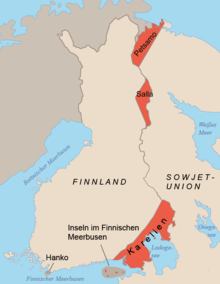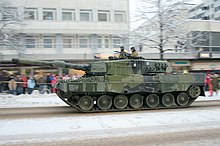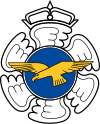Defense Forces of Finland
|
|||

|
|||
| guide | |||
|---|---|---|---|
| Commander in Chief : | Sauli Niinistö | ||
| Defense Minister: | Antti Kaikkonen | ||
| Military Commander: | Timo Kivinen | ||
| Military strength | |||
| Active soldiers: | 35,000 | ||
| Conscription: | Yes | ||
| Resilient population: | almost 2,000,000 (men and women, ages 16–49; 2010) | ||
| Eligibility for military service: | 18 years | ||
| household | |||
| Military budget: | € 2,659,000,000 (2015) | ||
| Share of gross domestic product : | 1.29% (2015) | ||
| history | |||
| Founding: | 1918 | ||
The Defense Forces of Finland ( Finnish Puolustusvoimat , Swedish Försvarsmakten ) are the country's regular armed forces . In peacetime they have a strength of 35,000 men, 26,000 of them in the land forces, 5,000 in the sea forces and 4,000 in the air forces . In the event of war, up to 520,000 men can be put under arms in a short time, and the Finnish border guard with a war strength of 23,000 men can be subordinated to the Army Command. However, since 2008 the war reserve has been reduced to a strength of 430,000 soldiers. For comparison: At the height of the Cold War , a nominal peace force of 500,000 men was foreseen for the Bundeswehr . With a population of around 5.4 million, almost 10% of the population would be under arms in the event of war.
history
The detachment of Finland from Sweden in 1809 led to the creation of the autonomous Grand Duchy of Finland . As Grand Duke of Finland, the Russian Tsar was also the head of state of Finland. During the time of the Grand Duchy, Finland was largely spared from direct acts of war with the exception of the destruction during the Crimean War . The defense of the Russian external border and thus the Grand Duchy of Finland, as a Russian vassal, was taken over by Russian army units. The Finnish armed forces were not organizationally integrated into the Imperial Russian Army and were nevertheless reorganized several times in order to better integrate them into the Russian Army. The Finnish Guard , a body regiment of the tsar, gained respect during operations in Russian wars outside Finland. After the Tsar passed a conscription law in 1901 against the resistance of the Finnish autonomous organs as part of the Russification policy , which abolished the separate Finnish armed forces and made the citizens of Finland subject to conscription in the army of the Russian Empire, the Finnish constitutionalists organized passive resistance, and from 1902 onwards they offered Most of the conscripts do not follow the draft. The implementation of the conscription law was suspended in 1905, the Finnish armed forces were completely abolished. At the First World War were Finnish soldiers, apart from some volunteers not involved. In the hope of a defeat for Russia in the war, the so-called hunter movement made contact with Germany and finally in 1915 sent around 2,000 volunteers for military training in the German army . The hunter battalion formed in this way was partly deployed at the front and thus gained military experience that was otherwise rarely found in Finland.
After the February Revolution in Russia, the Finnish Parliament declared Finland's independence on December 6, 1917 . The process of detachment from Russia was accompanied by severe internal conflicts that culminated on January 27, 1918 in an attempted socialist coup. In a three-month civil war , the bourgeois “ whites ” ultimately got the upper hand. In 1919 Finland adopted a republican constitution . A peace and border treaty was signed with Soviet Russia in 1920, on the basis of which the borders of Finland coincided with the former Grand Duchy, but Finland was also granted the Petsamo area with its access to the North Sea . The German-Soviet non-aggression pact , signed in 1939, assigned Finland to the Soviet sphere of interest. The attack by the Soviet Union on Finland on November 30, 1939 marked the beginning of the Winter War . Despite numerous successful defensive battles, the Finnish defense under its Commander-in-Chief Carl Gustaf Emil Mannerheim was on the verge of collapse when the war was ended on March 13, 1940 by the Moscow Peace Treaty. Finland had to cede large parts of Karelia , including Vyborg, which was then the second largest city in the country, and other areas to the Soviet Union. When Hitler invaded the Soviet Union on June 22, 1941 , in breach of the non-aggression pact , Finland entered into the war in cooperation with Germany, which in Finland is referred to as the Continuation War . The Finnish army not only recaptured the lost territories, but also penetrated deeply into the Soviet Union's East Karelia with the aim of bringing together the closely related ethnic groups, regarded by many Finns as national comrades, in a greater Finland . In 1944, however, after the successes of the Red Army , Finland had to withdraw from the occupied territories and was again faced with the threat of Soviet occupation. On September 19, 1944, it concluded the separate peace in Moscow with the Soviet Union , which ended the Continuation War. The territorial losses of the Winter War were confirmed, and the Petsamo area had to be ceded.
The separate peace obliged Finland to drive the German troops out of the country, and so the Finnish-German Lapland War followed, which ended on April 27, 1945 with the withdrawal of the last German soldiers from Kilpisjärvi . The state of war with the Allies was finally ended by the Paris Peace Treaty of 1947. In 1948 a friendship and cooperation agreement was concluded with the Soviet Union , which, after being extended several times, remained in force until the end of the Soviet Union. The strength of the armed forces and the procurement of new defense technology were initially strictly regulated. It was not until the end of the 1950s that the modernization of the armament of the Finnish army began. Weapon systems were acquired in roughly equal parts in the Soviet Union and in the West.
Until joining the Council of Europe in 1990 (after the fall of the Iron Curtain ), Finland remained strictly neutral and was therefore often criticized for “hasty obedience” to the Soviet Union ( Finlandization ). In retrospect, the author Sofi Oksanen spoke in 2014 of a state of “reduced independence, gnawed democracy and stifled freedom of expression”. After the collapse of the Soviet Union , the regulations on the procurement of new defense technology were lifted.
organization
The President Sauli Niinistö is in accordance with the constitutional commander of the Finnish Defense Forces. Antti Kaikkonen has been Minister of Defense since June 2019 . General Timo Kivinen has been Chief of Defense since August 2019 .
In 2006 the budget of the Finnish Armed Forces accounted for around 5.7% of the total budget and in absolute terms was 2.274 billion euros. The share of military spending in the gross national product is 1.6%, which roughly corresponds to the figure for Germany, but is well below the overall European average.
According to Section 127 of the Finnish Constitution, general conscription applies . Military service lasts between six and twelve months, depending on the level of training. Although it is possible to refuse military service and to do a civil twelve-month alternative service, more than 80% of a birth cohort do military service. Every year around 27,000 conscripts are trained, and up to 35,000 Finns are called up for reserve exercises. Only Jehovah's Witnesses and residents of the autonomous province of Åland are expressly excluded from military service . Since 1995 women have been able to do voluntary military service.
Land forces
The land forces (Maavoimat in Finnish, Landmakten in Swedish ) play a key role in the Finnish defense strategy (territorial defense), not least because of the large land area; they maintain a wide-meshed network of bases and material stores throughout the country. They include, among other things, units of the infantry (hunters), artillery , anti-aircraft artillery , as well as pioneers as well as communication and logistics units.
The land forces are divided into three commandos and twelve provinces: West ( Vaasa , Central Finland , Uusimaa , Häme , Helsinki , Turku and Pori ), North ( Lapland and Oulu ) and East ( Kuopio , North Karelia , Mikkeli and Kymi ).
The standard assault rifle of the Finnish army is the Valmet RK 62 7.62 mm, a further development of the Soviet Kalashnikov , which is manufactured by the domestic arms factories Valmet and Sako . The tank arsenal comprises 230 main battle tanks and over 1,200 other armored vehicles, for example Sisu Pasi transport tanks .
With the FRDF ( Finnish Rapid Deployment Force , Finnish: Suomen Kansainvälinen Valmiusjoukko ) , the Finnish Army has had a rapid reaction force for acute crisis operations since 1996 .
Air forces

The air forces ( Finnish Ilmavoimat , Swedish Luftmakten ) were founded on March 6, 1918 and are among the oldest in the world. The headquarters and the aviation academy are located in Tikkakoski near Jyväskylä, other bases are Rovaniemi, Tampere, Kauhava in Österbotten, the Kuopio airport in Siilinjärvi and Halli in central Finland. The task of the air force is to secure and defend the Finnish airspace. Since the military leadership assumes that enemy air attacks in case of defense pose the greatest danger to the country, the establishment of the Air Force is focused defensively. In contrast to the army and navy, the air force operates at full readiness even in peacetime. It has a total of 160 aircraft.
The core of the fleet is currently made up of 64 American -made F-18 Hornets fighters . There are also 57 BAe Hawk Mk51 / 51A trainers / attack aircraft and various transport and training aircraft.
Sea forces
The naval forces ( Finnish Merivoimat , Swedish Havmakten ) include both the actual navy and units of coastal artillery and marine infantry . The naval headquarters are in the Lauttasaari district of Helsinki , and the naval academy is on the island fortress of Suomenlinna . Further bases are Upinniemi (near Kirkkonummi ), Pansio ( Turku ), Dragsvik ( Ekenäs ) and the ports of Hamina and Kotka .
The fleet is adapted to the strategic conditions of the Finnish archipelago, but not set up for open sea warfare . Therefore the ships are relatively small. The fleet includes 8 missile speedboats, 13 mine clearers, 6 mine-layers, landing craft and various transport and auxiliary ships. At the Paris Peace Conference in 1946 Finland pledged to renounce torpedo and submarines. Although President Mauno Koivisto annulled this agreement after the collapse of the Soviet Union, Finland has made no effort to expand its fleet in this regard. A particularly ambitious attempt at modernization by the Finnish Navy was the development of the Tuuli class . Only the type ship Tuuli was built. The project, which was successful in itself, was discontinued for budget reasons. The Finnish Navy uses almost exclusively native designs for ships. The fleet currently consists of:
- 4 Hamina-class missile speedboats
- 4 Rauma-class missile speedboats
- 2 Kiisla class patrol boats
- 1 Pohjanmaa-class mine-layer
- 2 mine layers of the Hämeenmaa class
- 6 Kuha class deminers
- 7 Kiiski-class deminers
- 3 minelayers of the Pansio class
Individual evidence
- ^ US State Department
- ↑ Finnish Defense Forces: Continuous Training ( Memento of the original from April 20, 2010 in the Internet Archive ) Info: The archive link was inserted automatically and has not yet been checked. Please check the original and archive link according to the instructions and then remove this notice.
- ^ Bundeswehr: Conditionally ready for defense . In: Der Spiegel . No. 41 , 1962 ( online ).
- ^ Eckhard Fuhr: Book fair: What Germany can learn from Finland. In: welt.de . October 7, 2014, accessed January 5, 2017 .
- ↑ defmin.fi
- ↑ defmin.fi
- ↑ defmin.fi
- ↑ virtual.finland.fi ( memento of the original from September 25, 2006 in the Internet Archive ) Info: The archive link was inserted automatically and has not yet been checked. Please check the original and archive link according to the instructions and then remove this notice.
- ^ The World Defense Almanac 2006, Mönch Publishing Group, Bonn 2006.
- ↑ ilmavoimat.fi Mission of Finnish Air Force ( Memento of the original from November 15, 2006 in the Internet Archive ) Info: The archive link has been inserted automatically and has not yet been checked. Please check the original and archive link according to the instructions and then remove this notice.
Web links
- Official website of the Finnish Armed Forces (Finnish, Swedish and English)
- Ministry of Defense website (Finnish, Swedish and English)







